supply chain management and business ethics
VerifiedAdded on 2022/08/20
|15
|3771
|14
AI Summary
Contribute Materials
Your contribution can guide someone’s learning journey. Share your
documents today.
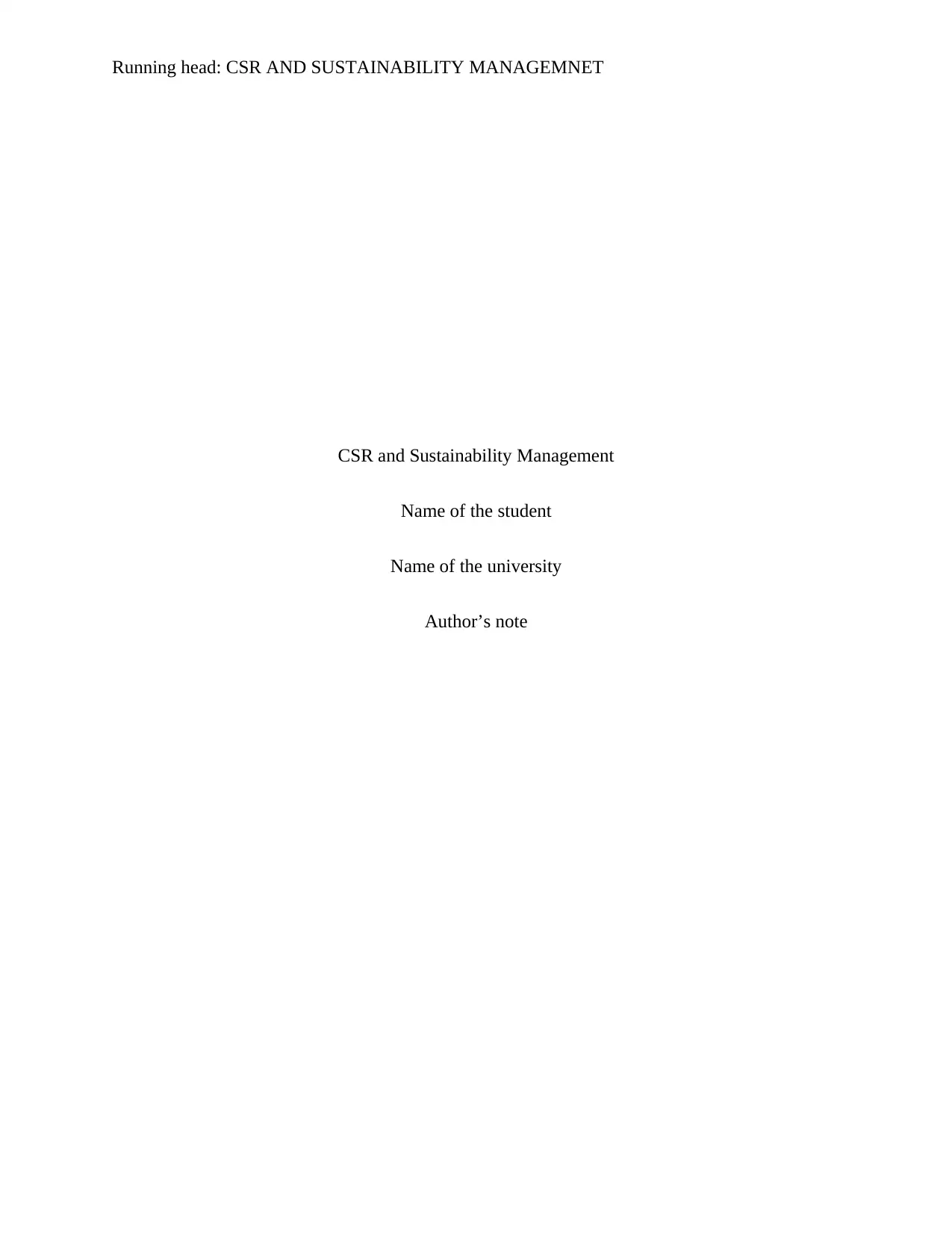
Running head: CSR AND SUSTAINABILITY MANAGEMNET
CSR and Sustainability Management
Name of the student
Name of the university
Author’s note
CSR and Sustainability Management
Name of the student
Name of the university
Author’s note
Secure Best Marks with AI Grader
Need help grading? Try our AI Grader for instant feedback on your assignments.
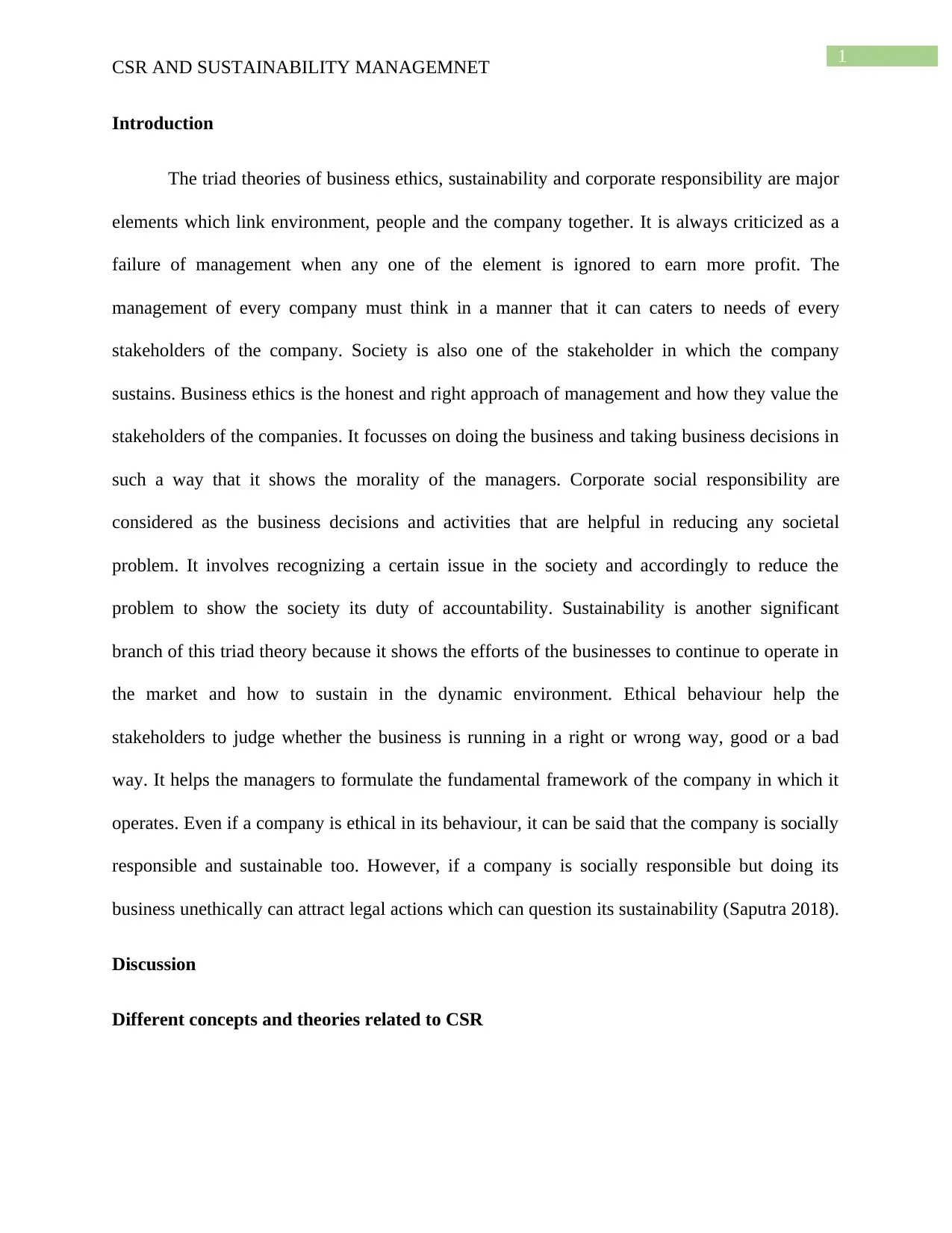
1
CSR AND SUSTAINABILITY MANAGEMNET
Introduction
The triad theories of business ethics, sustainability and corporate responsibility are major
elements which link environment, people and the company together. It is always criticized as a
failure of management when any one of the element is ignored to earn more profit. The
management of every company must think in a manner that it can caters to needs of every
stakeholders of the company. Society is also one of the stakeholder in which the company
sustains. Business ethics is the honest and right approach of management and how they value the
stakeholders of the companies. It focusses on doing the business and taking business decisions in
such a way that it shows the morality of the managers. Corporate social responsibility are
considered as the business decisions and activities that are helpful in reducing any societal
problem. It involves recognizing a certain issue in the society and accordingly to reduce the
problem to show the society its duty of accountability. Sustainability is another significant
branch of this triad theory because it shows the efforts of the businesses to continue to operate in
the market and how to sustain in the dynamic environment. Ethical behaviour help the
stakeholders to judge whether the business is running in a right or wrong way, good or a bad
way. It helps the managers to formulate the fundamental framework of the company in which it
operates. Even if a company is ethical in its behaviour, it can be said that the company is socially
responsible and sustainable too. However, if a company is socially responsible but doing its
business unethically can attract legal actions which can question its sustainability (Saputra 2018).
Discussion
Different concepts and theories related to CSR
CSR AND SUSTAINABILITY MANAGEMNET
Introduction
The triad theories of business ethics, sustainability and corporate responsibility are major
elements which link environment, people and the company together. It is always criticized as a
failure of management when any one of the element is ignored to earn more profit. The
management of every company must think in a manner that it can caters to needs of every
stakeholders of the company. Society is also one of the stakeholder in which the company
sustains. Business ethics is the honest and right approach of management and how they value the
stakeholders of the companies. It focusses on doing the business and taking business decisions in
such a way that it shows the morality of the managers. Corporate social responsibility are
considered as the business decisions and activities that are helpful in reducing any societal
problem. It involves recognizing a certain issue in the society and accordingly to reduce the
problem to show the society its duty of accountability. Sustainability is another significant
branch of this triad theory because it shows the efforts of the businesses to continue to operate in
the market and how to sustain in the dynamic environment. Ethical behaviour help the
stakeholders to judge whether the business is running in a right or wrong way, good or a bad
way. It helps the managers to formulate the fundamental framework of the company in which it
operates. Even if a company is ethical in its behaviour, it can be said that the company is socially
responsible and sustainable too. However, if a company is socially responsible but doing its
business unethically can attract legal actions which can question its sustainability (Saputra 2018).
Discussion
Different concepts and theories related to CSR
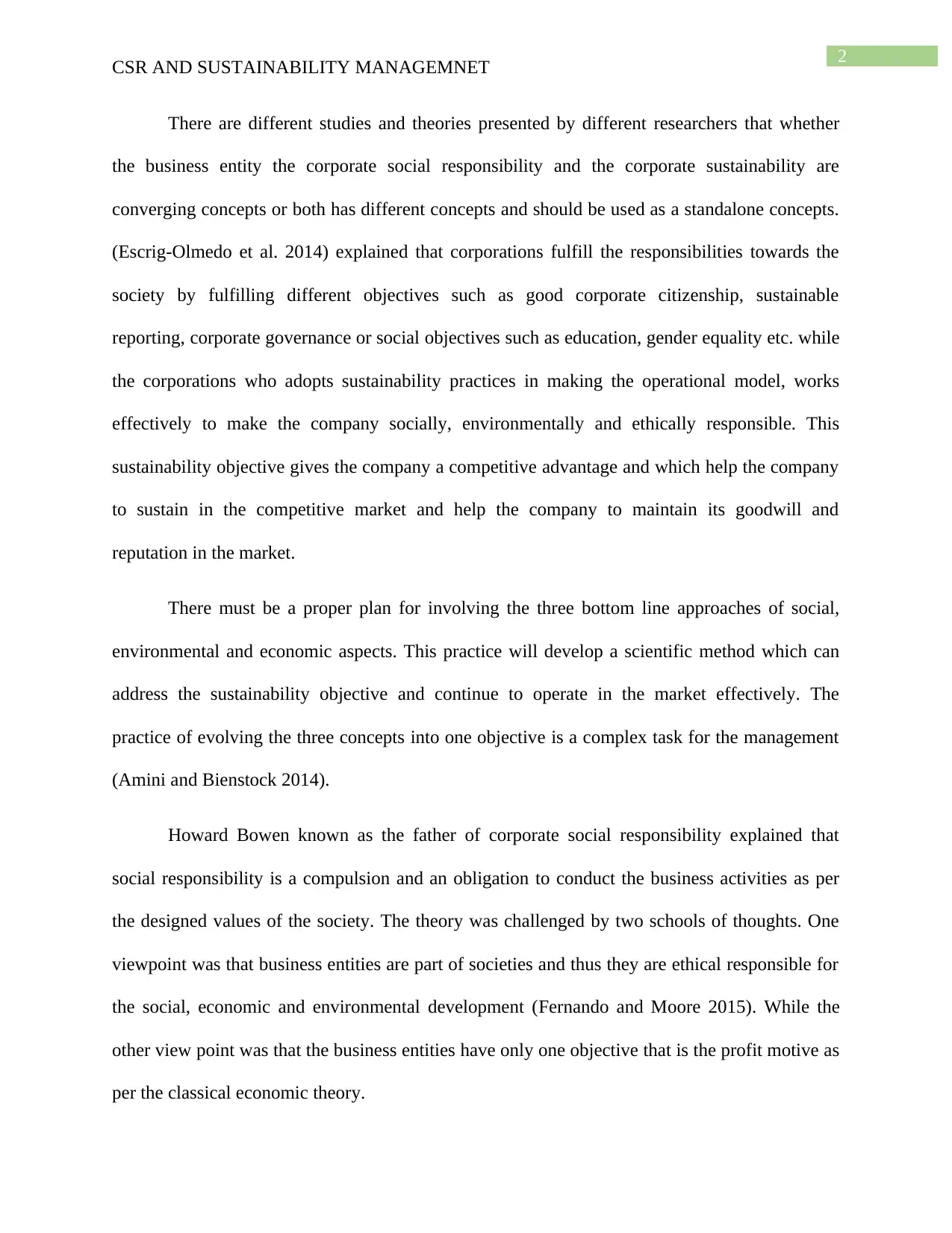
2
CSR AND SUSTAINABILITY MANAGEMNET
There are different studies and theories presented by different researchers that whether
the business entity the corporate social responsibility and the corporate sustainability are
converging concepts or both has different concepts and should be used as a standalone concepts.
(Escrig-Olmedo et al. 2014) explained that corporations fulfill the responsibilities towards the
society by fulfilling different objectives such as good corporate citizenship, sustainable
reporting, corporate governance or social objectives such as education, gender equality etc. while
the corporations who adopts sustainability practices in making the operational model, works
effectively to make the company socially, environmentally and ethically responsible. This
sustainability objective gives the company a competitive advantage and which help the company
to sustain in the competitive market and help the company to maintain its goodwill and
reputation in the market.
There must be a proper plan for involving the three bottom line approaches of social,
environmental and economic aspects. This practice will develop a scientific method which can
address the sustainability objective and continue to operate in the market effectively. The
practice of evolving the three concepts into one objective is a complex task for the management
(Amini and Bienstock 2014).
Howard Bowen known as the father of corporate social responsibility explained that
social responsibility is a compulsion and an obligation to conduct the business activities as per
the designed values of the society. The theory was challenged by two schools of thoughts. One
viewpoint was that business entities are part of societies and thus they are ethical responsible for
the social, economic and environmental development (Fernando and Moore 2015). While the
other view point was that the business entities have only one objective that is the profit motive as
per the classical economic theory.
CSR AND SUSTAINABILITY MANAGEMNET
There are different studies and theories presented by different researchers that whether
the business entity the corporate social responsibility and the corporate sustainability are
converging concepts or both has different concepts and should be used as a standalone concepts.
(Escrig-Olmedo et al. 2014) explained that corporations fulfill the responsibilities towards the
society by fulfilling different objectives such as good corporate citizenship, sustainable
reporting, corporate governance or social objectives such as education, gender equality etc. while
the corporations who adopts sustainability practices in making the operational model, works
effectively to make the company socially, environmentally and ethically responsible. This
sustainability objective gives the company a competitive advantage and which help the company
to sustain in the competitive market and help the company to maintain its goodwill and
reputation in the market.
There must be a proper plan for involving the three bottom line approaches of social,
environmental and economic aspects. This practice will develop a scientific method which can
address the sustainability objective and continue to operate in the market effectively. The
practice of evolving the three concepts into one objective is a complex task for the management
(Amini and Bienstock 2014).
Howard Bowen known as the father of corporate social responsibility explained that
social responsibility is a compulsion and an obligation to conduct the business activities as per
the designed values of the society. The theory was challenged by two schools of thoughts. One
viewpoint was that business entities are part of societies and thus they are ethical responsible for
the social, economic and environmental development (Fernando and Moore 2015). While the
other view point was that the business entities have only one objective that is the profit motive as
per the classical economic theory.
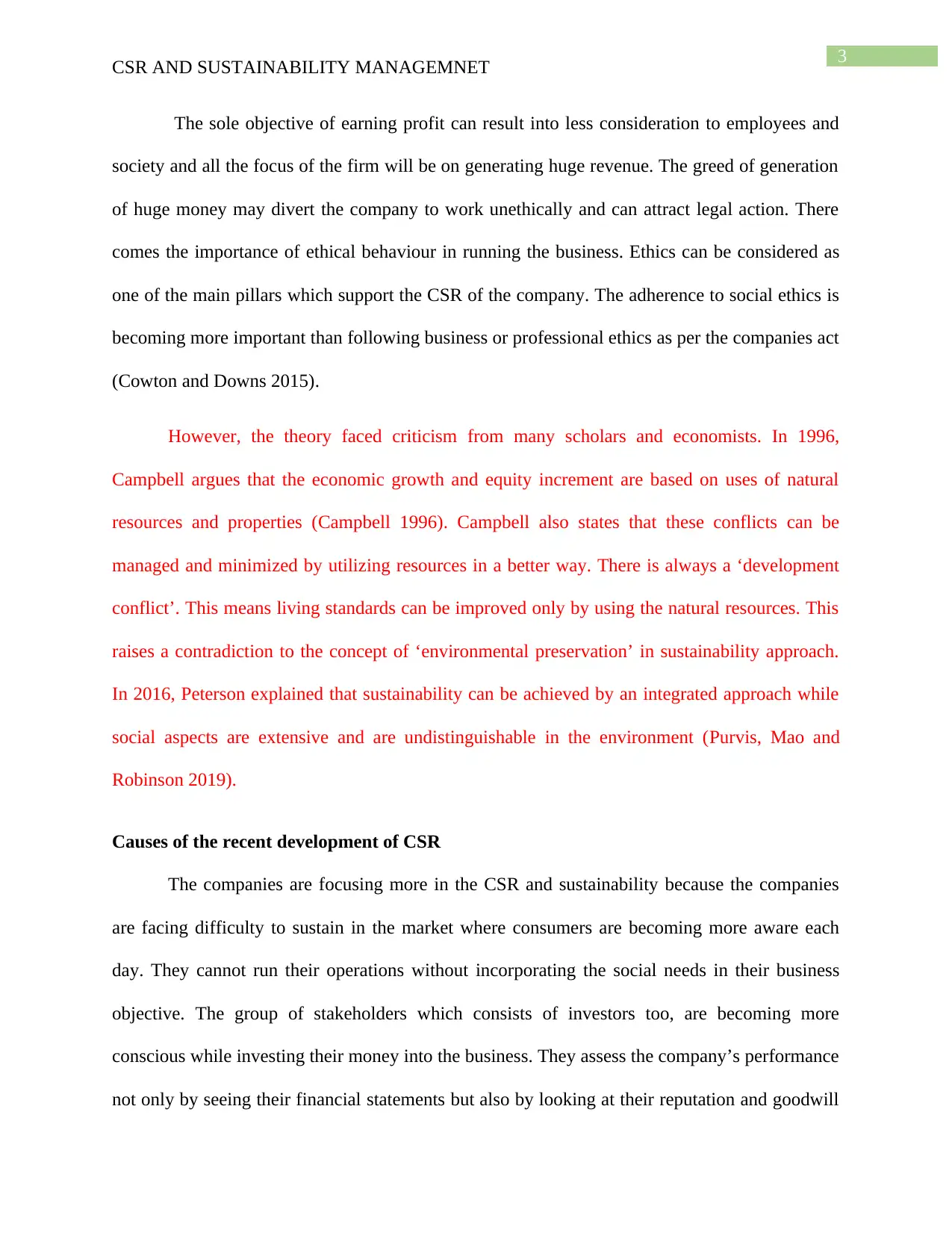
3
CSR AND SUSTAINABILITY MANAGEMNET
The sole objective of earning profit can result into less consideration to employees and
society and all the focus of the firm will be on generating huge revenue. The greed of generation
of huge money may divert the company to work unethically and can attract legal action. There
comes the importance of ethical behaviour in running the business. Ethics can be considered as
one of the main pillars which support the CSR of the company. The adherence to social ethics is
becoming more important than following business or professional ethics as per the companies act
(Cowton and Downs 2015).
However, the theory faced criticism from many scholars and economists. In 1996,
Campbell argues that the economic growth and equity increment are based on uses of natural
resources and properties (Campbell 1996). Campbell also states that these conflicts can be
managed and minimized by utilizing resources in a better way. There is always a ‘development
conflict’. This means living standards can be improved only by using the natural resources. This
raises a contradiction to the concept of ‘environmental preservation’ in sustainability approach.
In 2016, Peterson explained that sustainability can be achieved by an integrated approach while
social aspects are extensive and are undistinguishable in the environment (Purvis, Mao and
Robinson 2019).
Causes of the recent development of CSR
The companies are focusing more in the CSR and sustainability because the companies
are facing difficulty to sustain in the market where consumers are becoming more aware each
day. They cannot run their operations without incorporating the social needs in their business
objective. The group of stakeholders which consists of investors too, are becoming more
conscious while investing their money into the business. They assess the company’s performance
not only by seeing their financial statements but also by looking at their reputation and goodwill
CSR AND SUSTAINABILITY MANAGEMNET
The sole objective of earning profit can result into less consideration to employees and
society and all the focus of the firm will be on generating huge revenue. The greed of generation
of huge money may divert the company to work unethically and can attract legal action. There
comes the importance of ethical behaviour in running the business. Ethics can be considered as
one of the main pillars which support the CSR of the company. The adherence to social ethics is
becoming more important than following business or professional ethics as per the companies act
(Cowton and Downs 2015).
However, the theory faced criticism from many scholars and economists. In 1996,
Campbell argues that the economic growth and equity increment are based on uses of natural
resources and properties (Campbell 1996). Campbell also states that these conflicts can be
managed and minimized by utilizing resources in a better way. There is always a ‘development
conflict’. This means living standards can be improved only by using the natural resources. This
raises a contradiction to the concept of ‘environmental preservation’ in sustainability approach.
In 2016, Peterson explained that sustainability can be achieved by an integrated approach while
social aspects are extensive and are undistinguishable in the environment (Purvis, Mao and
Robinson 2019).
Causes of the recent development of CSR
The companies are focusing more in the CSR and sustainability because the companies
are facing difficulty to sustain in the market where consumers are becoming more aware each
day. They cannot run their operations without incorporating the social needs in their business
objective. The group of stakeholders which consists of investors too, are becoming more
conscious while investing their money into the business. They assess the company’s performance
not only by seeing their financial statements but also by looking at their reputation and goodwill
Secure Best Marks with AI Grader
Need help grading? Try our AI Grader for instant feedback on your assignments.
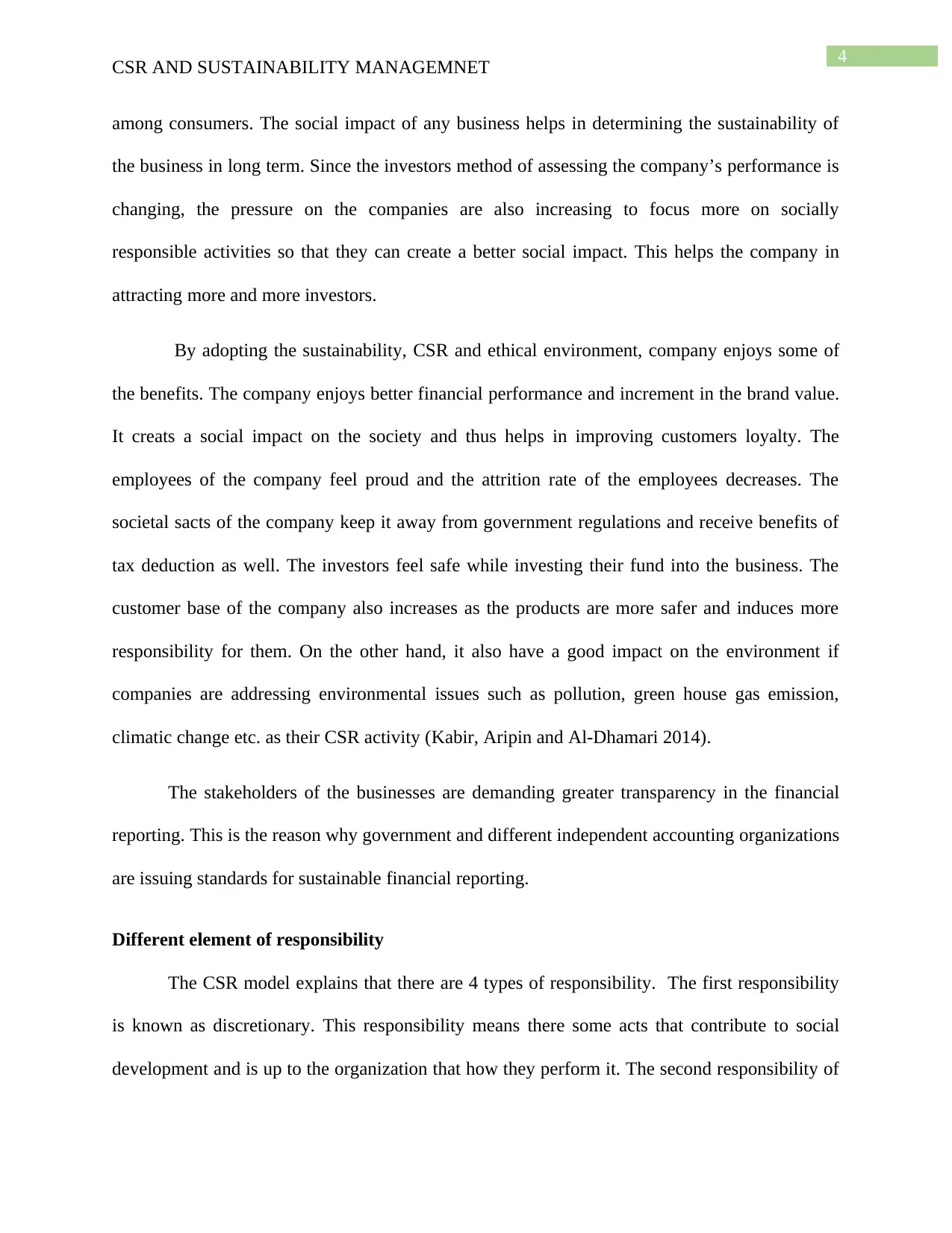
4
CSR AND SUSTAINABILITY MANAGEMNET
among consumers. The social impact of any business helps in determining the sustainability of
the business in long term. Since the investors method of assessing the company’s performance is
changing, the pressure on the companies are also increasing to focus more on socially
responsible activities so that they can create a better social impact. This helps the company in
attracting more and more investors.
By adopting the sustainability, CSR and ethical environment, company enjoys some of
the benefits. The company enjoys better financial performance and increment in the brand value.
It creats a social impact on the society and thus helps in improving customers loyalty. The
employees of the company feel proud and the attrition rate of the employees decreases. The
societal sacts of the company keep it away from government regulations and receive benefits of
tax deduction as well. The investors feel safe while investing their fund into the business. The
customer base of the company also increases as the products are more safer and induces more
responsibility for them. On the other hand, it also have a good impact on the environment if
companies are addressing environmental issues such as pollution, green house gas emission,
climatic change etc. as their CSR activity (Kabir, Aripin and Al-Dhamari 2014).
The stakeholders of the businesses are demanding greater transparency in the financial
reporting. This is the reason why government and different independent accounting organizations
are issuing standards for sustainable financial reporting.
Different element of responsibility
The CSR model explains that there are 4 types of responsibility. The first responsibility
is known as discretionary. This responsibility means there some acts that contribute to social
development and is up to the organization that how they perform it. The second responsibility of
CSR AND SUSTAINABILITY MANAGEMNET
among consumers. The social impact of any business helps in determining the sustainability of
the business in long term. Since the investors method of assessing the company’s performance is
changing, the pressure on the companies are also increasing to focus more on socially
responsible activities so that they can create a better social impact. This helps the company in
attracting more and more investors.
By adopting the sustainability, CSR and ethical environment, company enjoys some of
the benefits. The company enjoys better financial performance and increment in the brand value.
It creats a social impact on the society and thus helps in improving customers loyalty. The
employees of the company feel proud and the attrition rate of the employees decreases. The
societal sacts of the company keep it away from government regulations and receive benefits of
tax deduction as well. The investors feel safe while investing their fund into the business. The
customer base of the company also increases as the products are more safer and induces more
responsibility for them. On the other hand, it also have a good impact on the environment if
companies are addressing environmental issues such as pollution, green house gas emission,
climatic change etc. as their CSR activity (Kabir, Aripin and Al-Dhamari 2014).
The stakeholders of the businesses are demanding greater transparency in the financial
reporting. This is the reason why government and different independent accounting organizations
are issuing standards for sustainable financial reporting.
Different element of responsibility
The CSR model explains that there are 4 types of responsibility. The first responsibility
is known as discretionary. This responsibility means there some acts that contribute to social
development and is up to the organization that how they perform it. The second responsibility of
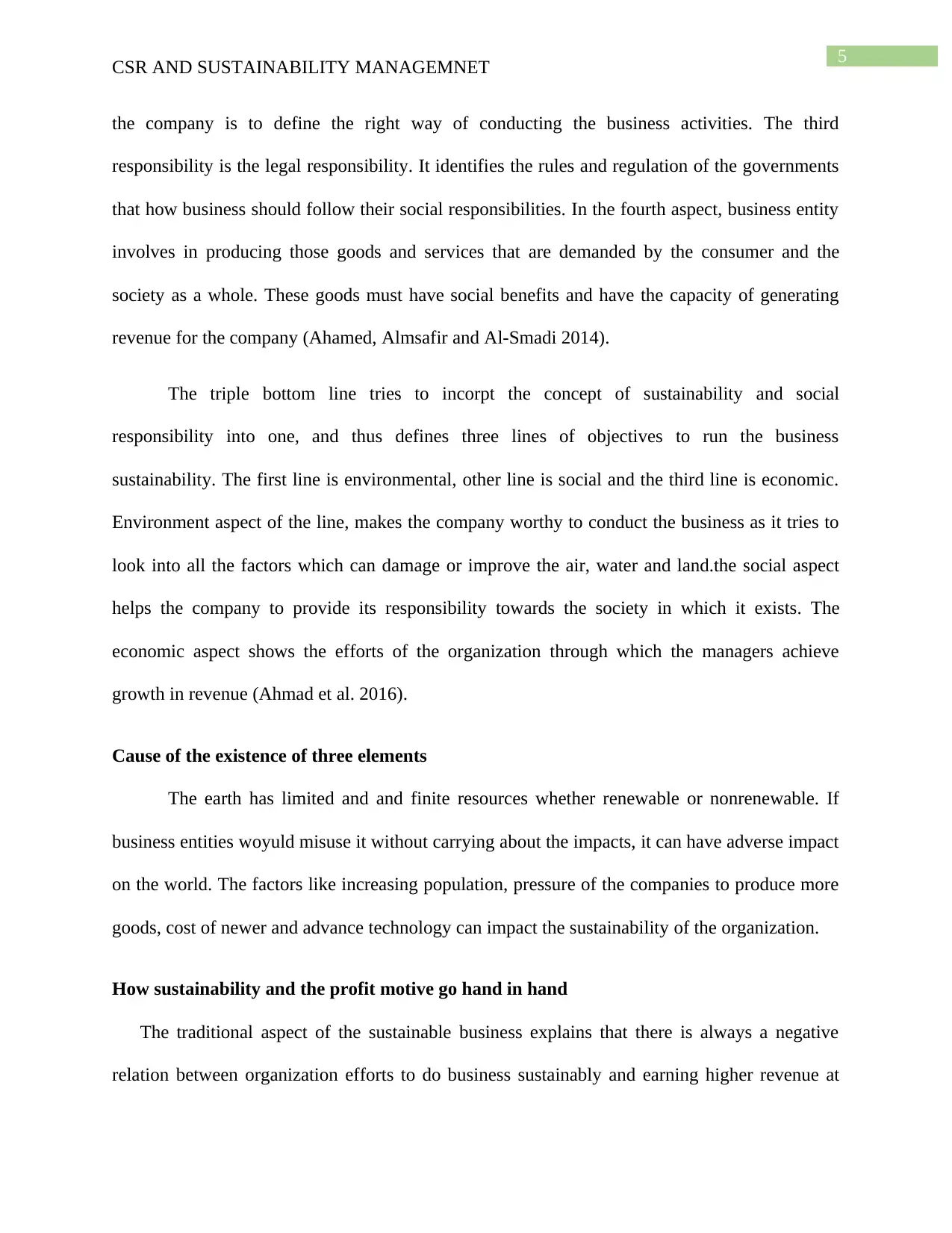
5
CSR AND SUSTAINABILITY MANAGEMNET
the company is to define the right way of conducting the business activities. The third
responsibility is the legal responsibility. It identifies the rules and regulation of the governments
that how business should follow their social responsibilities. In the fourth aspect, business entity
involves in producing those goods and services that are demanded by the consumer and the
society as a whole. These goods must have social benefits and have the capacity of generating
revenue for the company (Ahamed, Almsafir and Al-Smadi 2014).
The triple bottom line tries to incorpt the concept of sustainability and social
responsibility into one, and thus defines three lines of objectives to run the business
sustainability. The first line is environmental, other line is social and the third line is economic.
Environment aspect of the line, makes the company worthy to conduct the business as it tries to
look into all the factors which can damage or improve the air, water and land.the social aspect
helps the company to provide its responsibility towards the society in which it exists. The
economic aspect shows the efforts of the organization through which the managers achieve
growth in revenue (Ahmad et al. 2016).
Cause of the existence of three elements
The earth has limited and and finite resources whether renewable or nonrenewable. If
business entities woyuld misuse it without carrying about the impacts, it can have adverse impact
on the world. The factors like increasing population, pressure of the companies to produce more
goods, cost of newer and advance technology can impact the sustainability of the organization.
How sustainability and the profit motive go hand in hand
The traditional aspect of the sustainable business explains that there is always a negative
relation between organization efforts to do business sustainably and earning higher revenue at
CSR AND SUSTAINABILITY MANAGEMNET
the company is to define the right way of conducting the business activities. The third
responsibility is the legal responsibility. It identifies the rules and regulation of the governments
that how business should follow their social responsibilities. In the fourth aspect, business entity
involves in producing those goods and services that are demanded by the consumer and the
society as a whole. These goods must have social benefits and have the capacity of generating
revenue for the company (Ahamed, Almsafir and Al-Smadi 2014).
The triple bottom line tries to incorpt the concept of sustainability and social
responsibility into one, and thus defines three lines of objectives to run the business
sustainability. The first line is environmental, other line is social and the third line is economic.
Environment aspect of the line, makes the company worthy to conduct the business as it tries to
look into all the factors which can damage or improve the air, water and land.the social aspect
helps the company to provide its responsibility towards the society in which it exists. The
economic aspect shows the efforts of the organization through which the managers achieve
growth in revenue (Ahmad et al. 2016).
Cause of the existence of three elements
The earth has limited and and finite resources whether renewable or nonrenewable. If
business entities woyuld misuse it without carrying about the impacts, it can have adverse impact
on the world. The factors like increasing population, pressure of the companies to produce more
goods, cost of newer and advance technology can impact the sustainability of the organization.
How sustainability and the profit motive go hand in hand
The traditional aspect of the sustainable business explains that there is always a negative
relation between organization efforts to do business sustainably and earning higher revenue at
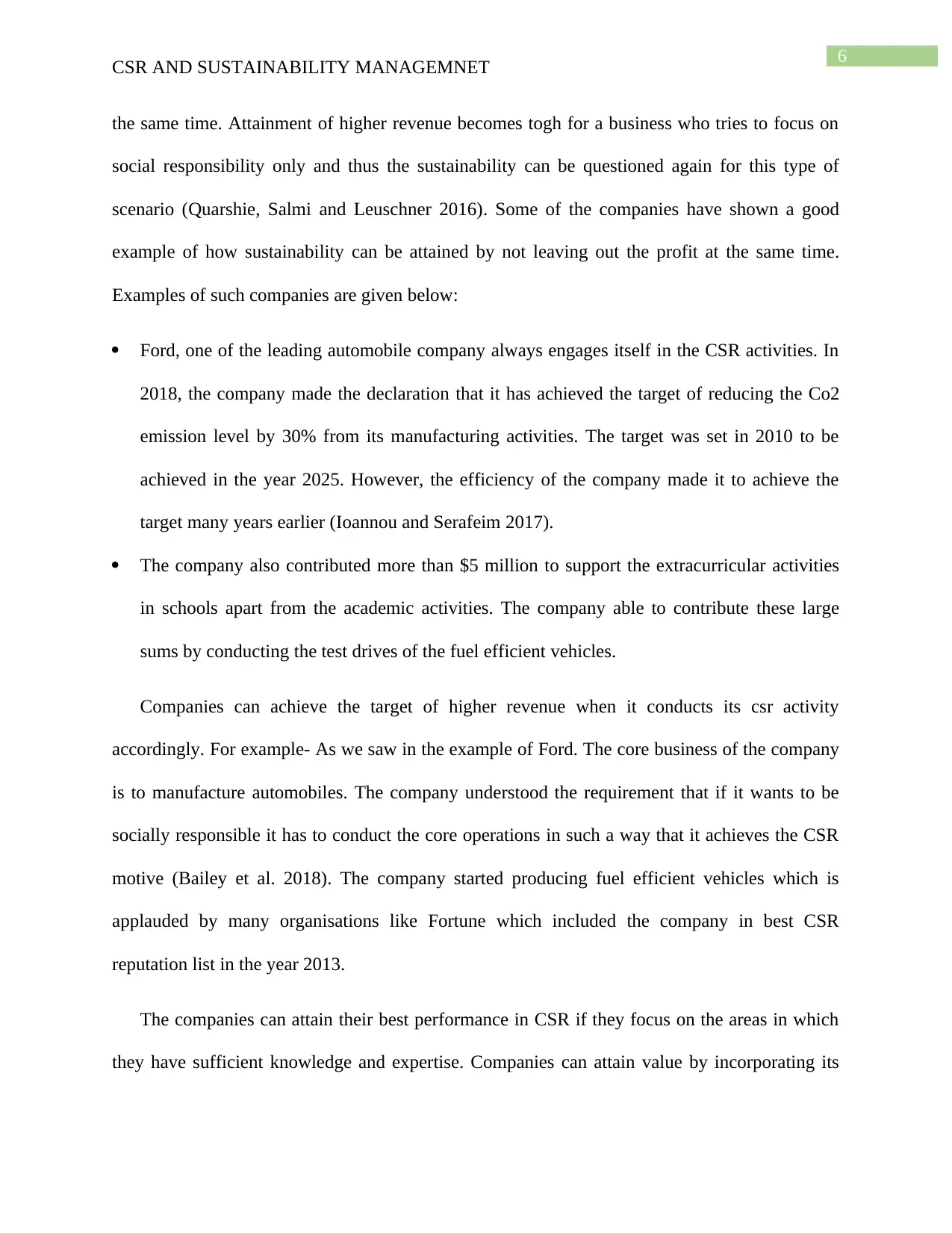
6
CSR AND SUSTAINABILITY MANAGEMNET
the same time. Attainment of higher revenue becomes togh for a business who tries to focus on
social responsibility only and thus the sustainability can be questioned again for this type of
scenario (Quarshie, Salmi and Leuschner 2016). Some of the companies have shown a good
example of how sustainability can be attained by not leaving out the profit at the same time.
Examples of such companies are given below:
Ford, one of the leading automobile company always engages itself in the CSR activities. In
2018, the company made the declaration that it has achieved the target of reducing the Co2
emission level by 30% from its manufacturing activities. The target was set in 2010 to be
achieved in the year 2025. However, the efficiency of the company made it to achieve the
target many years earlier (Ioannou and Serafeim 2017).
The company also contributed more than $5 million to support the extracurricular activities
in schools apart from the academic activities. The company able to contribute these large
sums by conducting the test drives of the fuel efficient vehicles.
Companies can achieve the target of higher revenue when it conducts its csr activity
accordingly. For example- As we saw in the example of Ford. The core business of the company
is to manufacture automobiles. The company understood the requirement that if it wants to be
socially responsible it has to conduct the core operations in such a way that it achieves the CSR
motive (Bailey et al. 2018). The company started producing fuel efficient vehicles which is
applauded by many organisations like Fortune which included the company in best CSR
reputation list in the year 2013.
The companies can attain their best performance in CSR if they focus on the areas in which
they have sufficient knowledge and expertise. Companies can attain value by incorporating its
CSR AND SUSTAINABILITY MANAGEMNET
the same time. Attainment of higher revenue becomes togh for a business who tries to focus on
social responsibility only and thus the sustainability can be questioned again for this type of
scenario (Quarshie, Salmi and Leuschner 2016). Some of the companies have shown a good
example of how sustainability can be attained by not leaving out the profit at the same time.
Examples of such companies are given below:
Ford, one of the leading automobile company always engages itself in the CSR activities. In
2018, the company made the declaration that it has achieved the target of reducing the Co2
emission level by 30% from its manufacturing activities. The target was set in 2010 to be
achieved in the year 2025. However, the efficiency of the company made it to achieve the
target many years earlier (Ioannou and Serafeim 2017).
The company also contributed more than $5 million to support the extracurricular activities
in schools apart from the academic activities. The company able to contribute these large
sums by conducting the test drives of the fuel efficient vehicles.
Companies can achieve the target of higher revenue when it conducts its csr activity
accordingly. For example- As we saw in the example of Ford. The core business of the company
is to manufacture automobiles. The company understood the requirement that if it wants to be
socially responsible it has to conduct the core operations in such a way that it achieves the CSR
motive (Bailey et al. 2018). The company started producing fuel efficient vehicles which is
applauded by many organisations like Fortune which included the company in best CSR
reputation list in the year 2013.
The companies can attain their best performance in CSR if they focus on the areas in which
they have sufficient knowledge and expertise. Companies can attain value by incorporating its
Paraphrase This Document
Need a fresh take? Get an instant paraphrase of this document with our AI Paraphraser
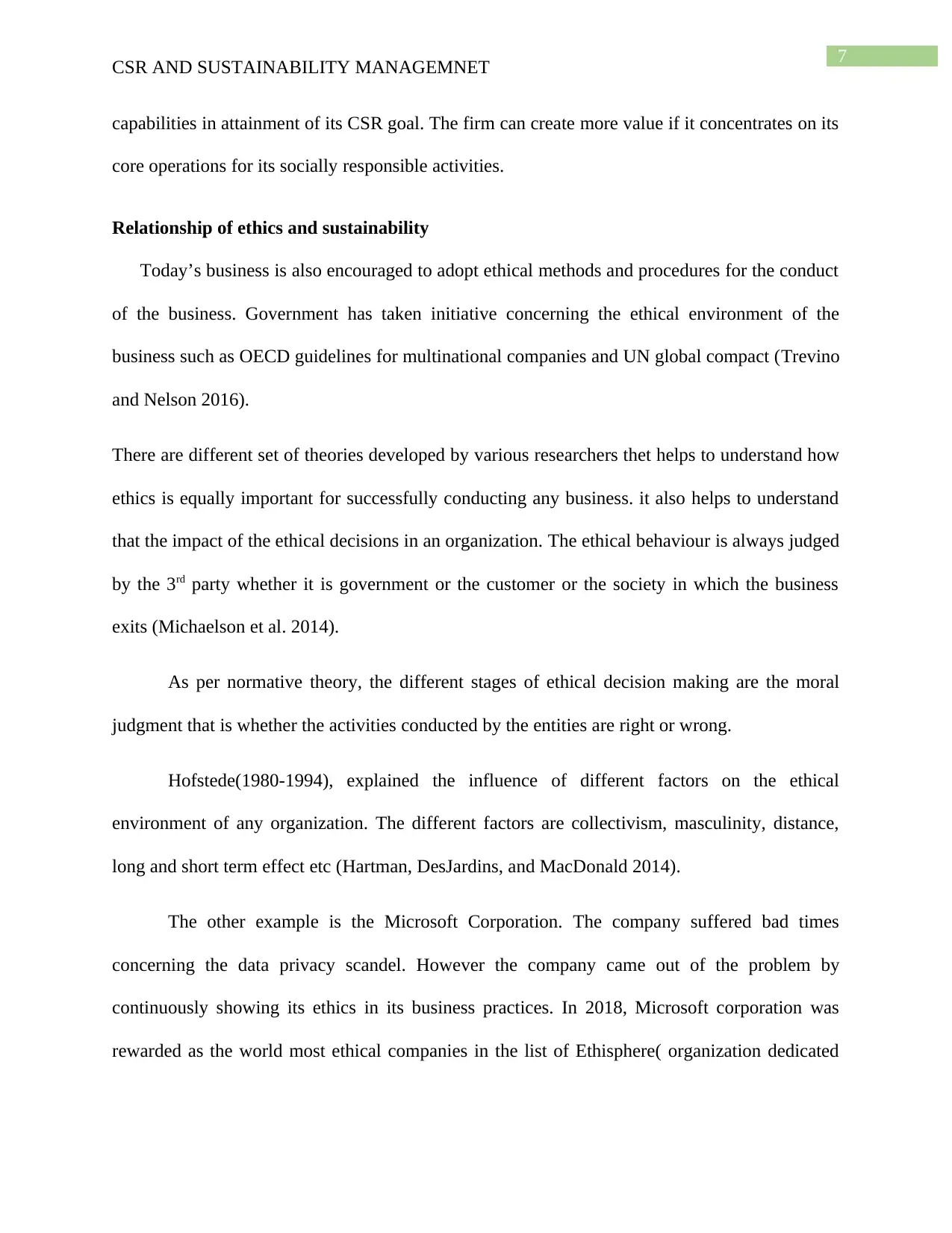
7
CSR AND SUSTAINABILITY MANAGEMNET
capabilities in attainment of its CSR goal. The firm can create more value if it concentrates on its
core operations for its socially responsible activities.
Relationship of ethics and sustainability
Today’s business is also encouraged to adopt ethical methods and procedures for the conduct
of the business. Government has taken initiative concerning the ethical environment of the
business such as OECD guidelines for multinational companies and UN global compact (Trevino
and Nelson 2016).
There are different set of theories developed by various researchers thet helps to understand how
ethics is equally important for successfully conducting any business. it also helps to understand
that the impact of the ethical decisions in an organization. The ethical behaviour is always judged
by the 3rd party whether it is government or the customer or the society in which the business
exits (Michaelson et al. 2014).
As per normative theory, the different stages of ethical decision making are the moral
judgment that is whether the activities conducted by the entities are right or wrong.
Hofstede(1980-1994), explained the influence of different factors on the ethical
environment of any organization. The different factors are collectivism, masculinity, distance,
long and short term effect etc (Hartman, DesJardins, and MacDonald 2014).
The other example is the Microsoft Corporation. The company suffered bad times
concerning the data privacy scandel. However the company came out of the problem by
continuously showing its ethics in its business practices. In 2018, Microsoft corporation was
rewarded as the world most ethical companies in the list of Ethisphere( organization dedicated
CSR AND SUSTAINABILITY MANAGEMNET
capabilities in attainment of its CSR goal. The firm can create more value if it concentrates on its
core operations for its socially responsible activities.
Relationship of ethics and sustainability
Today’s business is also encouraged to adopt ethical methods and procedures for the conduct
of the business. Government has taken initiative concerning the ethical environment of the
business such as OECD guidelines for multinational companies and UN global compact (Trevino
and Nelson 2016).
There are different set of theories developed by various researchers thet helps to understand how
ethics is equally important for successfully conducting any business. it also helps to understand
that the impact of the ethical decisions in an organization. The ethical behaviour is always judged
by the 3rd party whether it is government or the customer or the society in which the business
exits (Michaelson et al. 2014).
As per normative theory, the different stages of ethical decision making are the moral
judgment that is whether the activities conducted by the entities are right or wrong.
Hofstede(1980-1994), explained the influence of different factors on the ethical
environment of any organization. The different factors are collectivism, masculinity, distance,
long and short term effect etc (Hartman, DesJardins, and MacDonald 2014).
The other example is the Microsoft Corporation. The company suffered bad times
concerning the data privacy scandel. However the company came out of the problem by
continuously showing its ethics in its business practices. In 2018, Microsoft corporation was
rewarded as the world most ethical companies in the list of Ethisphere( organization dedicated
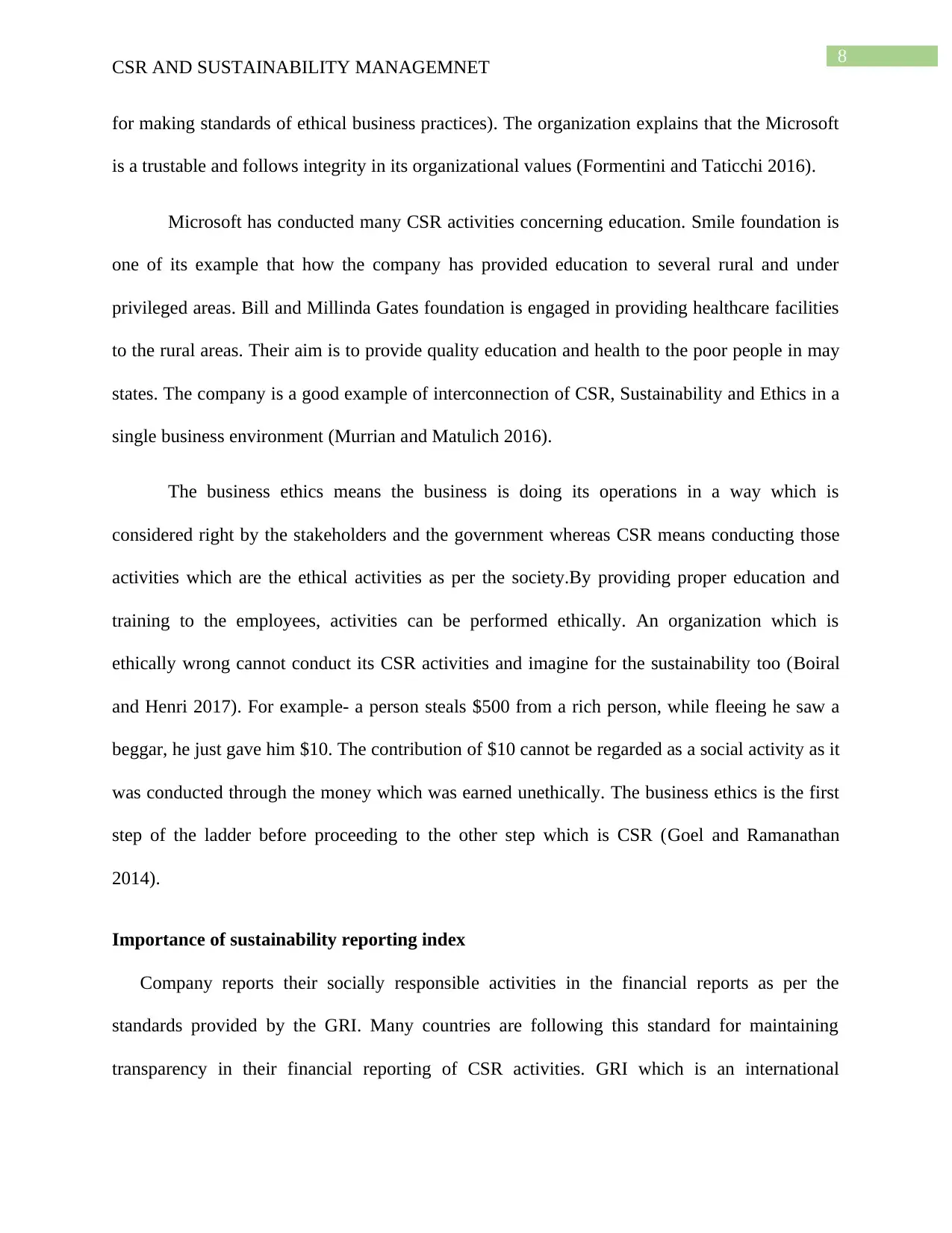
8
CSR AND SUSTAINABILITY MANAGEMNET
for making standards of ethical business practices). The organization explains that the Microsoft
is a trustable and follows integrity in its organizational values (Formentini and Taticchi 2016).
Microsoft has conducted many CSR activities concerning education. Smile foundation is
one of its example that how the company has provided education to several rural and under
privileged areas. Bill and Millinda Gates foundation is engaged in providing healthcare facilities
to the rural areas. Their aim is to provide quality education and health to the poor people in may
states. The company is a good example of interconnection of CSR, Sustainability and Ethics in a
single business environment (Murrian and Matulich 2016).
The business ethics means the business is doing its operations in a way which is
considered right by the stakeholders and the government whereas CSR means conducting those
activities which are the ethical activities as per the society.By providing proper education and
training to the employees, activities can be performed ethically. An organization which is
ethically wrong cannot conduct its CSR activities and imagine for the sustainability too (Boiral
and Henri 2017). For example- a person steals $500 from a rich person, while fleeing he saw a
beggar, he just gave him $10. The contribution of $10 cannot be regarded as a social activity as it
was conducted through the money which was earned unethically. The business ethics is the first
step of the ladder before proceeding to the other step which is CSR (Goel and Ramanathan
2014).
Importance of sustainability reporting index
Company reports their socially responsible activities in the financial reports as per the
standards provided by the GRI. Many countries are following this standard for maintaining
transparency in their financial reporting of CSR activities. GRI which is an international
CSR AND SUSTAINABILITY MANAGEMNET
for making standards of ethical business practices). The organization explains that the Microsoft
is a trustable and follows integrity in its organizational values (Formentini and Taticchi 2016).
Microsoft has conducted many CSR activities concerning education. Smile foundation is
one of its example that how the company has provided education to several rural and under
privileged areas. Bill and Millinda Gates foundation is engaged in providing healthcare facilities
to the rural areas. Their aim is to provide quality education and health to the poor people in may
states. The company is a good example of interconnection of CSR, Sustainability and Ethics in a
single business environment (Murrian and Matulich 2016).
The business ethics means the business is doing its operations in a way which is
considered right by the stakeholders and the government whereas CSR means conducting those
activities which are the ethical activities as per the society.By providing proper education and
training to the employees, activities can be performed ethically. An organization which is
ethically wrong cannot conduct its CSR activities and imagine for the sustainability too (Boiral
and Henri 2017). For example- a person steals $500 from a rich person, while fleeing he saw a
beggar, he just gave him $10. The contribution of $10 cannot be regarded as a social activity as it
was conducted through the money which was earned unethically. The business ethics is the first
step of the ladder before proceeding to the other step which is CSR (Goel and Ramanathan
2014).
Importance of sustainability reporting index
Company reports their socially responsible activities in the financial reports as per the
standards provided by the GRI. Many countries are following this standard for maintaining
transparency in their financial reporting of CSR activities. GRI which is an international
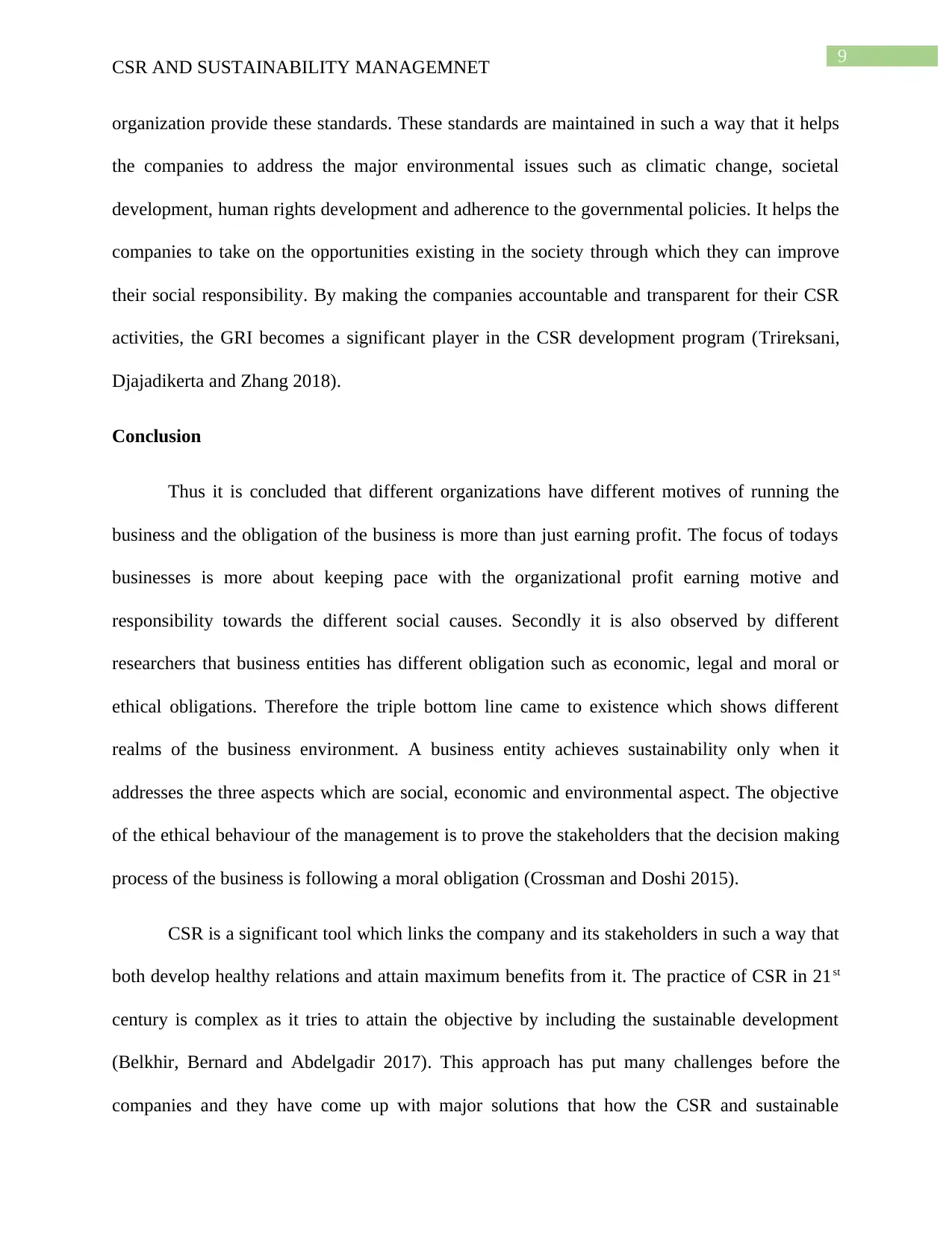
9
CSR AND SUSTAINABILITY MANAGEMNET
organization provide these standards. These standards are maintained in such a way that it helps
the companies to address the major environmental issues such as climatic change, societal
development, human rights development and adherence to the governmental policies. It helps the
companies to take on the opportunities existing in the society through which they can improve
their social responsibility. By making the companies accountable and transparent for their CSR
activities, the GRI becomes a significant player in the CSR development program (Trireksani,
Djajadikerta and Zhang 2018).
Conclusion
Thus it is concluded that different organizations have different motives of running the
business and the obligation of the business is more than just earning profit. The focus of todays
businesses is more about keeping pace with the organizational profit earning motive and
responsibility towards the different social causes. Secondly it is also observed by different
researchers that business entities has different obligation such as economic, legal and moral or
ethical obligations. Therefore the triple bottom line came to existence which shows different
realms of the business environment. A business entity achieves sustainability only when it
addresses the three aspects which are social, economic and environmental aspect. The objective
of the ethical behaviour of the management is to prove the stakeholders that the decision making
process of the business is following a moral obligation (Crossman and Doshi 2015).
CSR is a significant tool which links the company and its stakeholders in such a way that
both develop healthy relations and attain maximum benefits from it. The practice of CSR in 21st
century is complex as it tries to attain the objective by including the sustainable development
(Belkhir, Bernard and Abdelgadir 2017). This approach has put many challenges before the
companies and they have come up with major solutions that how the CSR and sustainable
CSR AND SUSTAINABILITY MANAGEMNET
organization provide these standards. These standards are maintained in such a way that it helps
the companies to address the major environmental issues such as climatic change, societal
development, human rights development and adherence to the governmental policies. It helps the
companies to take on the opportunities existing in the society through which they can improve
their social responsibility. By making the companies accountable and transparent for their CSR
activities, the GRI becomes a significant player in the CSR development program (Trireksani,
Djajadikerta and Zhang 2018).
Conclusion
Thus it is concluded that different organizations have different motives of running the
business and the obligation of the business is more than just earning profit. The focus of todays
businesses is more about keeping pace with the organizational profit earning motive and
responsibility towards the different social causes. Secondly it is also observed by different
researchers that business entities has different obligation such as economic, legal and moral or
ethical obligations. Therefore the triple bottom line came to existence which shows different
realms of the business environment. A business entity achieves sustainability only when it
addresses the three aspects which are social, economic and environmental aspect. The objective
of the ethical behaviour of the management is to prove the stakeholders that the decision making
process of the business is following a moral obligation (Crossman and Doshi 2015).
CSR is a significant tool which links the company and its stakeholders in such a way that
both develop healthy relations and attain maximum benefits from it. The practice of CSR in 21st
century is complex as it tries to attain the objective by including the sustainable development
(Belkhir, Bernard and Abdelgadir 2017). This approach has put many challenges before the
companies and they have come up with major solutions that how the CSR and sustainable
Secure Best Marks with AI Grader
Need help grading? Try our AI Grader for instant feedback on your assignments.
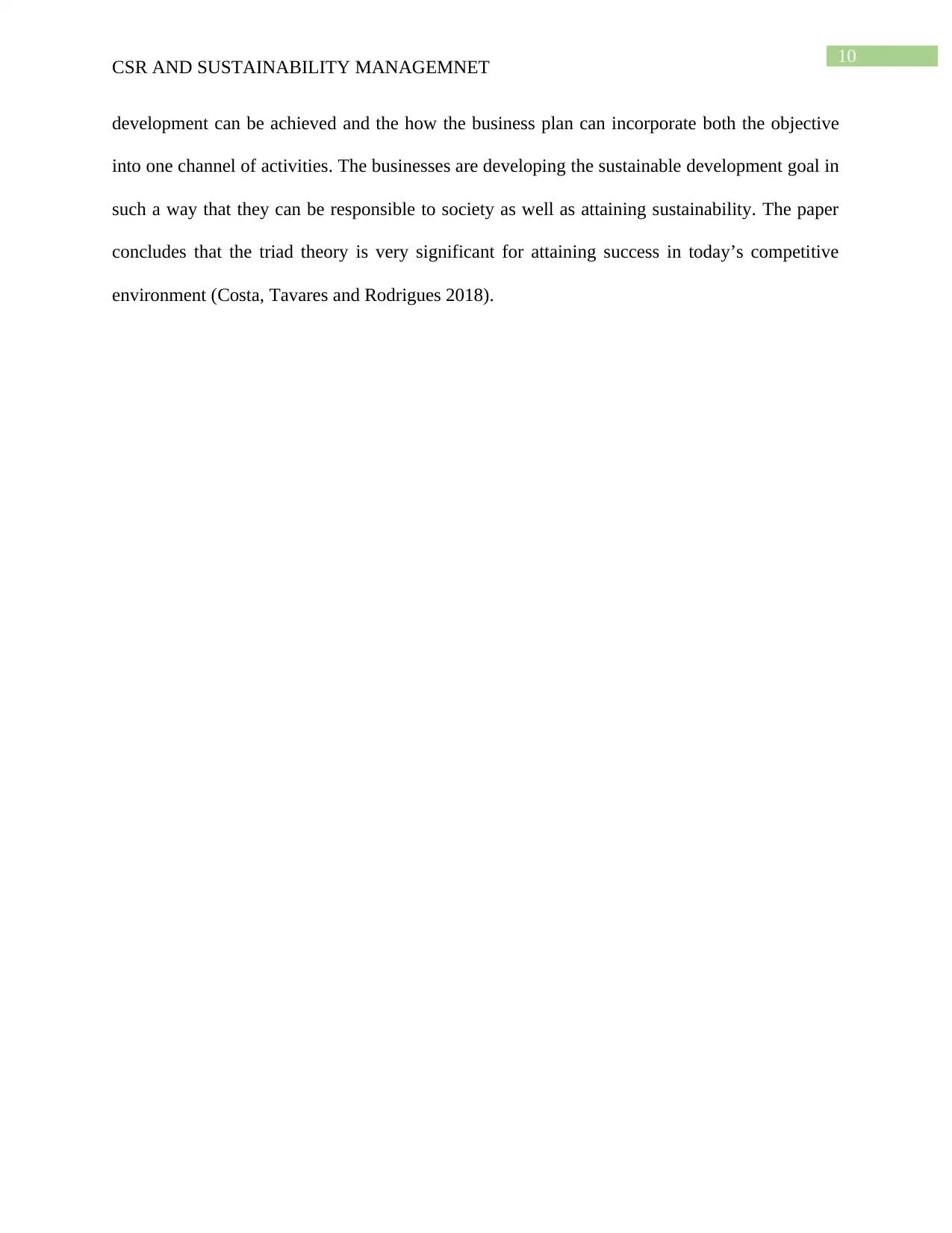
10
CSR AND SUSTAINABILITY MANAGEMNET
development can be achieved and the how the business plan can incorporate both the objective
into one channel of activities. The businesses are developing the sustainable development goal in
such a way that they can be responsible to society as well as attaining sustainability. The paper
concludes that the triad theory is very significant for attaining success in today’s competitive
environment (Costa, Tavares and Rodrigues 2018).
CSR AND SUSTAINABILITY MANAGEMNET
development can be achieved and the how the business plan can incorporate both the objective
into one channel of activities. The businesses are developing the sustainable development goal in
such a way that they can be responsible to society as well as attaining sustainability. The paper
concludes that the triad theory is very significant for attaining success in today’s competitive
environment (Costa, Tavares and Rodrigues 2018).
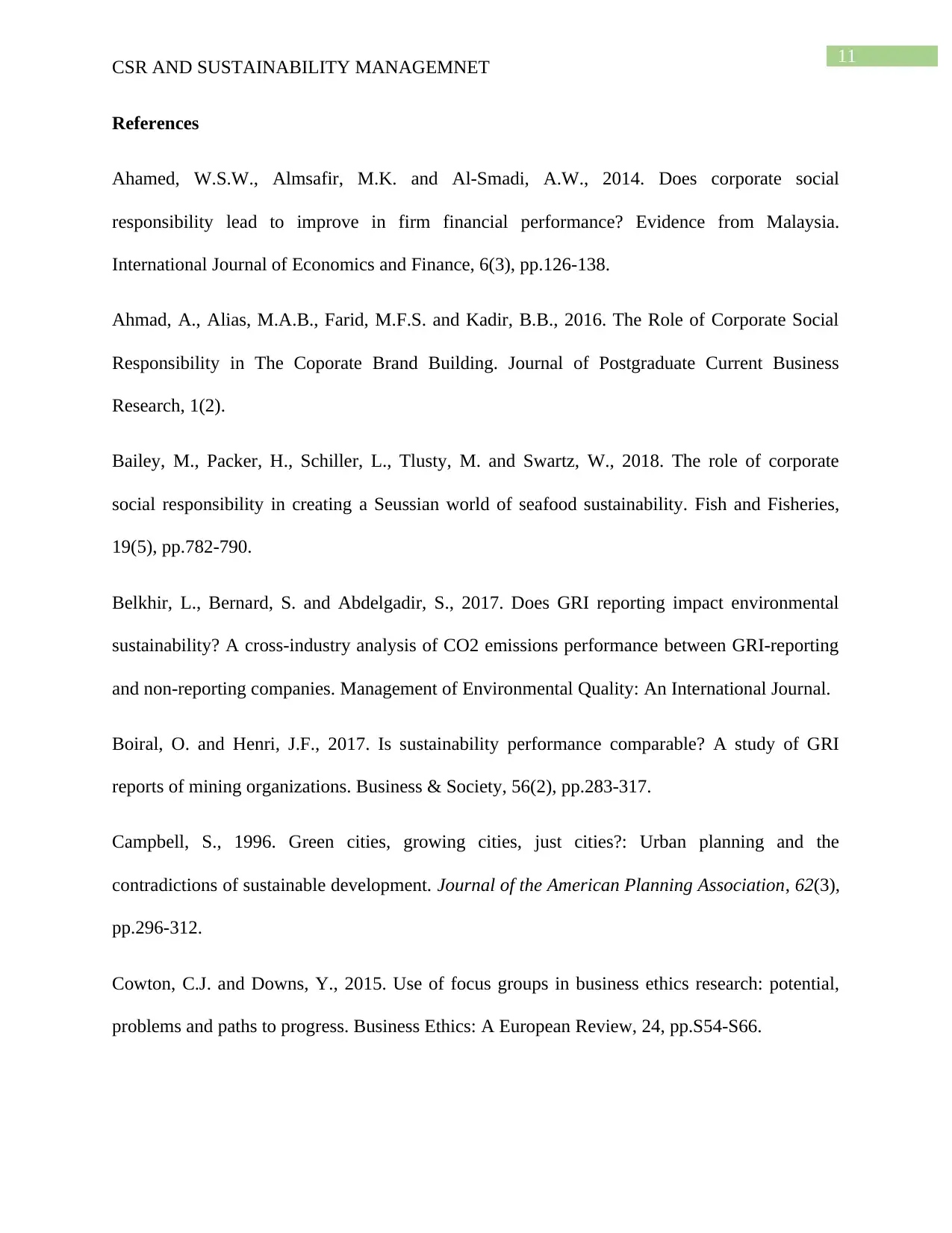
11
CSR AND SUSTAINABILITY MANAGEMNET
References
Ahamed, W.S.W., Almsafir, M.K. and Al-Smadi, A.W., 2014. Does corporate social
responsibility lead to improve in firm financial performance? Evidence from Malaysia.
International Journal of Economics and Finance, 6(3), pp.126-138.
Ahmad, A., Alias, M.A.B., Farid, M.F.S. and Kadir, B.B., 2016. The Role of Corporate Social
Responsibility in The Coporate Brand Building. Journal of Postgraduate Current Business
Research, 1(2).
Bailey, M., Packer, H., Schiller, L., Tlusty, M. and Swartz, W., 2018. The role of corporate
social responsibility in creating a Seussian world of seafood sustainability. Fish and Fisheries,
19(5), pp.782-790.
Belkhir, L., Bernard, S. and Abdelgadir, S., 2017. Does GRI reporting impact environmental
sustainability? A cross-industry analysis of CO2 emissions performance between GRI-reporting
and non-reporting companies. Management of Environmental Quality: An International Journal.
Boiral, O. and Henri, J.F., 2017. Is sustainability performance comparable? A study of GRI
reports of mining organizations. Business & Society, 56(2), pp.283-317.
Campbell, S., 1996. Green cities, growing cities, just cities?: Urban planning and the
contradictions of sustainable development. Journal of the American Planning Association, 62(3),
pp.296-312.
Cowton, C.J. and Downs, Y., 2015. Use of focus groups in business ethics research: potential,
problems and paths to progress. Business Ethics: A European Review, 24, pp.S54-S66.
CSR AND SUSTAINABILITY MANAGEMNET
References
Ahamed, W.S.W., Almsafir, M.K. and Al-Smadi, A.W., 2014. Does corporate social
responsibility lead to improve in firm financial performance? Evidence from Malaysia.
International Journal of Economics and Finance, 6(3), pp.126-138.
Ahmad, A., Alias, M.A.B., Farid, M.F.S. and Kadir, B.B., 2016. The Role of Corporate Social
Responsibility in The Coporate Brand Building. Journal of Postgraduate Current Business
Research, 1(2).
Bailey, M., Packer, H., Schiller, L., Tlusty, M. and Swartz, W., 2018. The role of corporate
social responsibility in creating a Seussian world of seafood sustainability. Fish and Fisheries,
19(5), pp.782-790.
Belkhir, L., Bernard, S. and Abdelgadir, S., 2017. Does GRI reporting impact environmental
sustainability? A cross-industry analysis of CO2 emissions performance between GRI-reporting
and non-reporting companies. Management of Environmental Quality: An International Journal.
Boiral, O. and Henri, J.F., 2017. Is sustainability performance comparable? A study of GRI
reports of mining organizations. Business & Society, 56(2), pp.283-317.
Campbell, S., 1996. Green cities, growing cities, just cities?: Urban planning and the
contradictions of sustainable development. Journal of the American Planning Association, 62(3),
pp.296-312.
Cowton, C.J. and Downs, Y., 2015. Use of focus groups in business ethics research: potential,
problems and paths to progress. Business Ethics: A European Review, 24, pp.S54-S66.
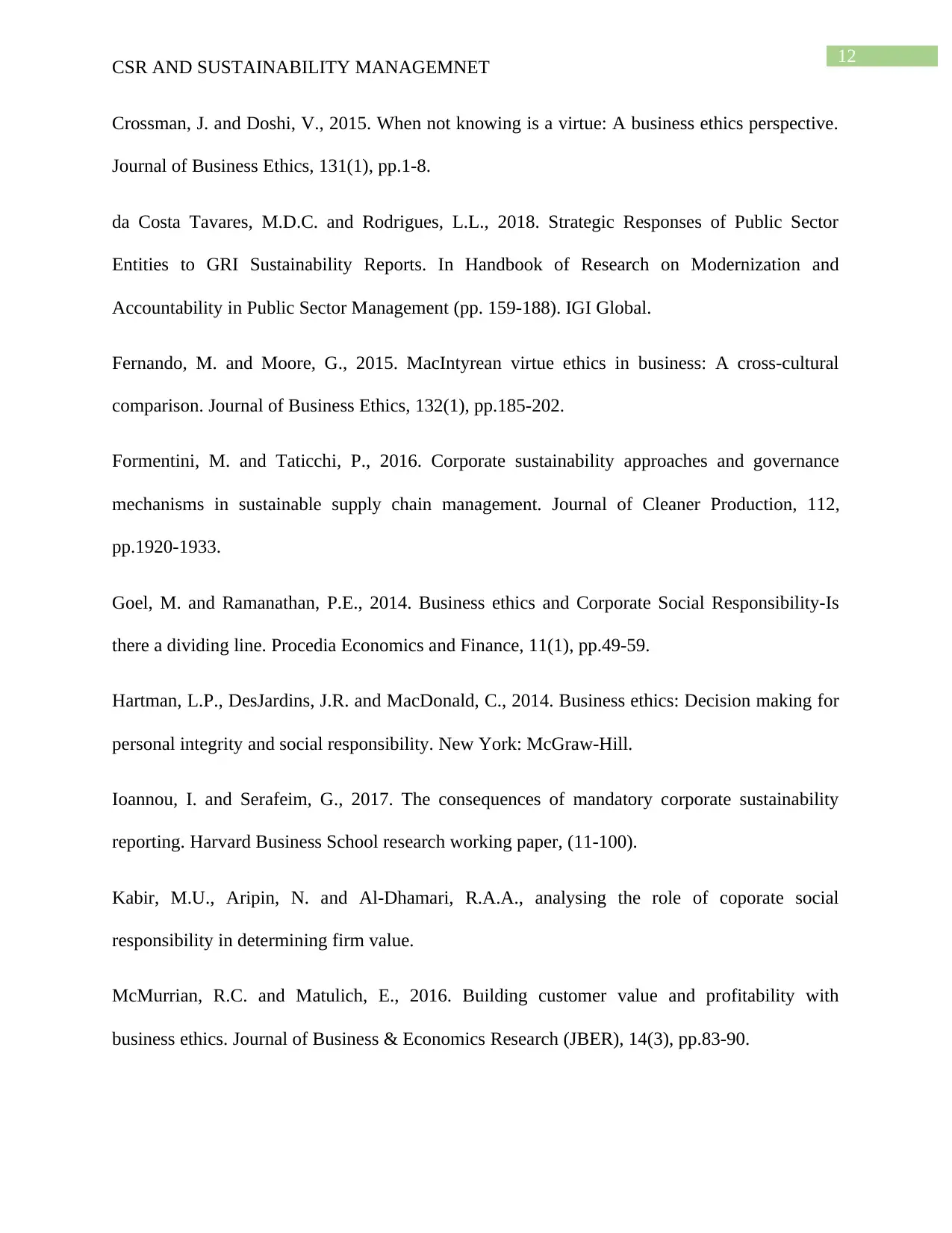
12
CSR AND SUSTAINABILITY MANAGEMNET
Crossman, J. and Doshi, V., 2015. When not knowing is a virtue: A business ethics perspective.
Journal of Business Ethics, 131(1), pp.1-8.
da Costa Tavares, M.D.C. and Rodrigues, L.L., 2018. Strategic Responses of Public Sector
Entities to GRI Sustainability Reports. In Handbook of Research on Modernization and
Accountability in Public Sector Management (pp. 159-188). IGI Global.
Fernando, M. and Moore, G., 2015. MacIntyrean virtue ethics in business: A cross-cultural
comparison. Journal of Business Ethics, 132(1), pp.185-202.
Formentini, M. and Taticchi, P., 2016. Corporate sustainability approaches and governance
mechanisms in sustainable supply chain management. Journal of Cleaner Production, 112,
pp.1920-1933.
Goel, M. and Ramanathan, P.E., 2014. Business ethics and Corporate Social Responsibility-Is
there a dividing line. Procedia Economics and Finance, 11(1), pp.49-59.
Hartman, L.P., DesJardins, J.R. and MacDonald, C., 2014. Business ethics: Decision making for
personal integrity and social responsibility. New York: McGraw-Hill.
Ioannou, I. and Serafeim, G., 2017. The consequences of mandatory corporate sustainability
reporting. Harvard Business School research working paper, (11-100).
Kabir, M.U., Aripin, N. and Al-Dhamari, R.A.A., analysing the role of coporate social
responsibility in determining firm value.
McMurrian, R.C. and Matulich, E., 2016. Building customer value and profitability with
business ethics. Journal of Business & Economics Research (JBER), 14(3), pp.83-90.
CSR AND SUSTAINABILITY MANAGEMNET
Crossman, J. and Doshi, V., 2015. When not knowing is a virtue: A business ethics perspective.
Journal of Business Ethics, 131(1), pp.1-8.
da Costa Tavares, M.D.C. and Rodrigues, L.L., 2018. Strategic Responses of Public Sector
Entities to GRI Sustainability Reports. In Handbook of Research on Modernization and
Accountability in Public Sector Management (pp. 159-188). IGI Global.
Fernando, M. and Moore, G., 2015. MacIntyrean virtue ethics in business: A cross-cultural
comparison. Journal of Business Ethics, 132(1), pp.185-202.
Formentini, M. and Taticchi, P., 2016. Corporate sustainability approaches and governance
mechanisms in sustainable supply chain management. Journal of Cleaner Production, 112,
pp.1920-1933.
Goel, M. and Ramanathan, P.E., 2014. Business ethics and Corporate Social Responsibility-Is
there a dividing line. Procedia Economics and Finance, 11(1), pp.49-59.
Hartman, L.P., DesJardins, J.R. and MacDonald, C., 2014. Business ethics: Decision making for
personal integrity and social responsibility. New York: McGraw-Hill.
Ioannou, I. and Serafeim, G., 2017. The consequences of mandatory corporate sustainability
reporting. Harvard Business School research working paper, (11-100).
Kabir, M.U., Aripin, N. and Al-Dhamari, R.A.A., analysing the role of coporate social
responsibility in determining firm value.
McMurrian, R.C. and Matulich, E., 2016. Building customer value and profitability with
business ethics. Journal of Business & Economics Research (JBER), 14(3), pp.83-90.
Paraphrase This Document
Need a fresh take? Get an instant paraphrase of this document with our AI Paraphraser
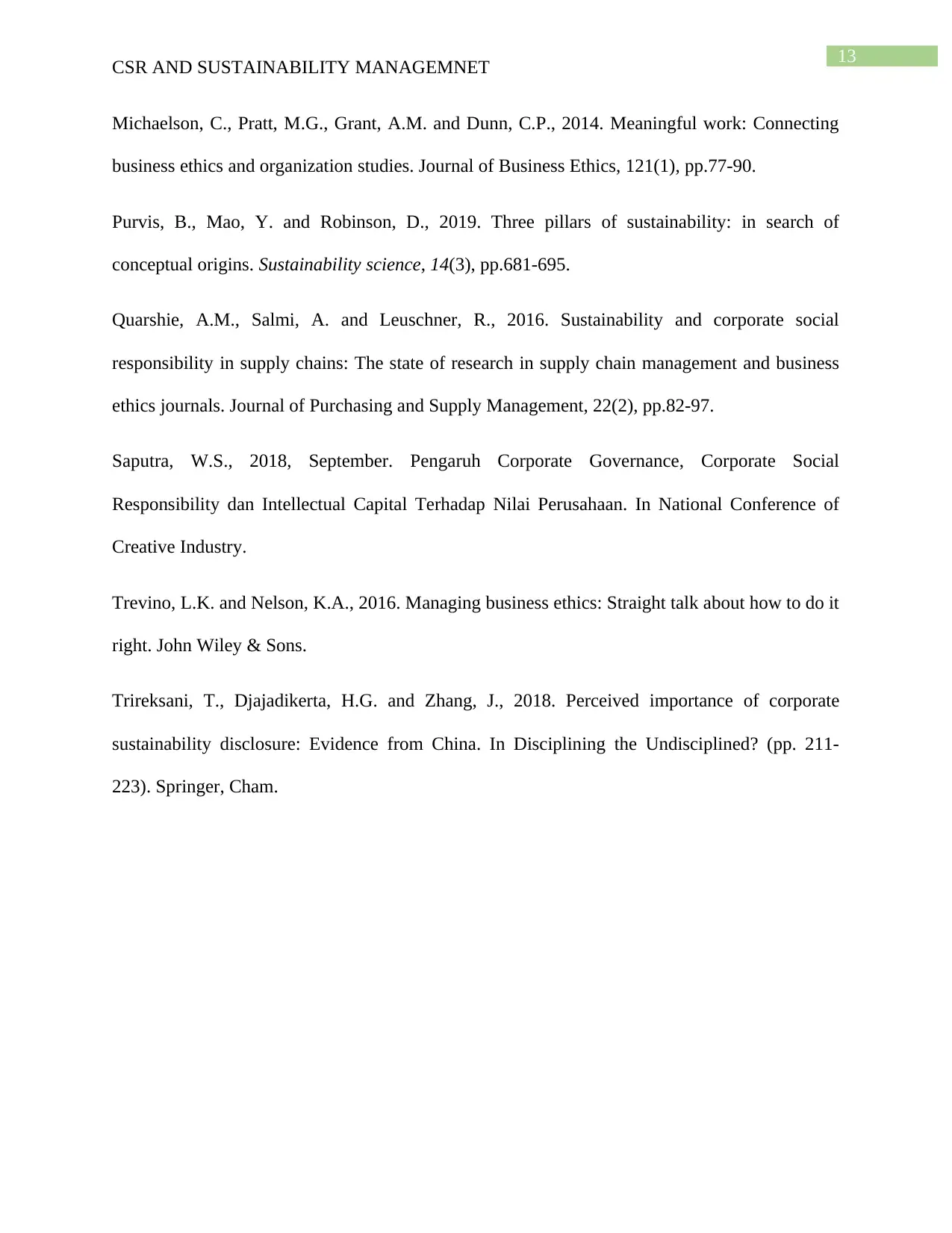
13
CSR AND SUSTAINABILITY MANAGEMNET
Michaelson, C., Pratt, M.G., Grant, A.M. and Dunn, C.P., 2014. Meaningful work: Connecting
business ethics and organization studies. Journal of Business Ethics, 121(1), pp.77-90.
Purvis, B., Mao, Y. and Robinson, D., 2019. Three pillars of sustainability: in search of
conceptual origins. Sustainability science, 14(3), pp.681-695.
Quarshie, A.M., Salmi, A. and Leuschner, R., 2016. Sustainability and corporate social
responsibility in supply chains: The state of research in supply chain management and business
ethics journals. Journal of Purchasing and Supply Management, 22(2), pp.82-97.
Saputra, W.S., 2018, September. Pengaruh Corporate Governance, Corporate Social
Responsibility dan Intellectual Capital Terhadap Nilai Perusahaan. In National Conference of
Creative Industry.
Trevino, L.K. and Nelson, K.A., 2016. Managing business ethics: Straight talk about how to do it
right. John Wiley & Sons.
Trireksani, T., Djajadikerta, H.G. and Zhang, J., 2018. Perceived importance of corporate
sustainability disclosure: Evidence from China. In Disciplining the Undisciplined? (pp. 211-
223). Springer, Cham.
CSR AND SUSTAINABILITY MANAGEMNET
Michaelson, C., Pratt, M.G., Grant, A.M. and Dunn, C.P., 2014. Meaningful work: Connecting
business ethics and organization studies. Journal of Business Ethics, 121(1), pp.77-90.
Purvis, B., Mao, Y. and Robinson, D., 2019. Three pillars of sustainability: in search of
conceptual origins. Sustainability science, 14(3), pp.681-695.
Quarshie, A.M., Salmi, A. and Leuschner, R., 2016. Sustainability and corporate social
responsibility in supply chains: The state of research in supply chain management and business
ethics journals. Journal of Purchasing and Supply Management, 22(2), pp.82-97.
Saputra, W.S., 2018, September. Pengaruh Corporate Governance, Corporate Social
Responsibility dan Intellectual Capital Terhadap Nilai Perusahaan. In National Conference of
Creative Industry.
Trevino, L.K. and Nelson, K.A., 2016. Managing business ethics: Straight talk about how to do it
right. John Wiley & Sons.
Trireksani, T., Djajadikerta, H.G. and Zhang, J., 2018. Perceived importance of corporate
sustainability disclosure: Evidence from China. In Disciplining the Undisciplined? (pp. 211-
223). Springer, Cham.

14
CSR AND SUSTAINABILITY MANAGEMNET
CSR AND SUSTAINABILITY MANAGEMNET
1 out of 15
Related Documents
Your All-in-One AI-Powered Toolkit for Academic Success.
+13062052269
info@desklib.com
Available 24*7 on WhatsApp / Email
![[object Object]](/_next/static/media/star-bottom.7253800d.svg)
Unlock your academic potential
© 2024 | Zucol Services PVT LTD | All rights reserved.





